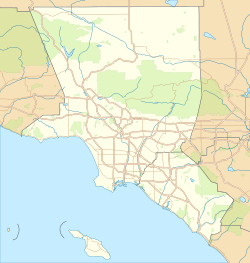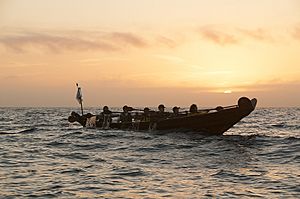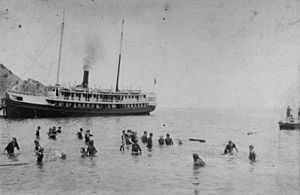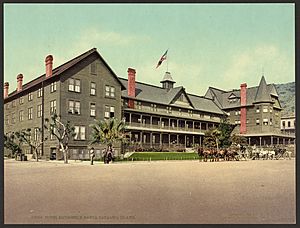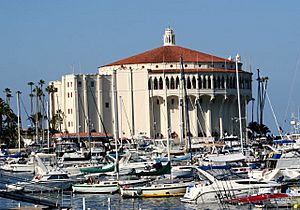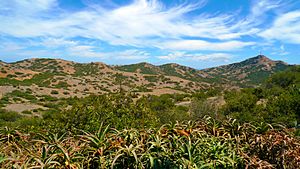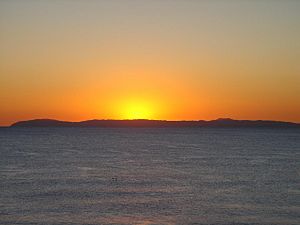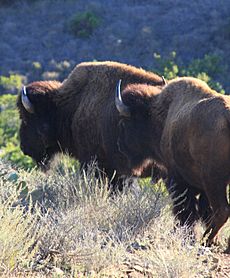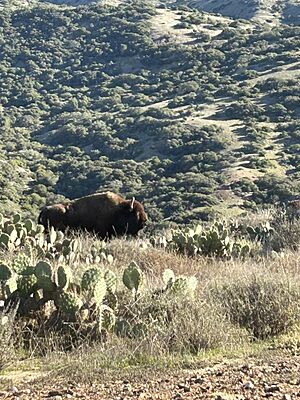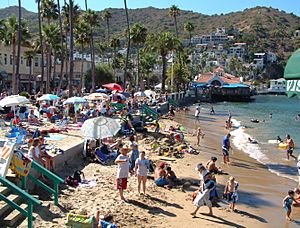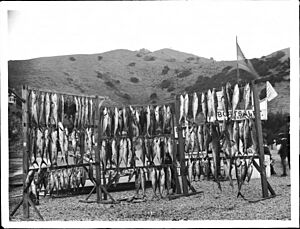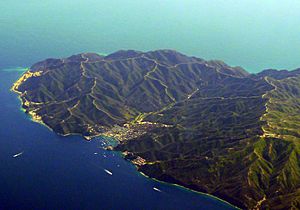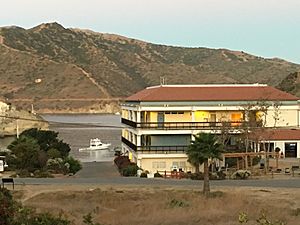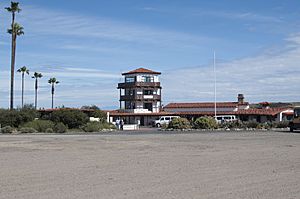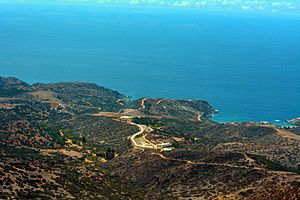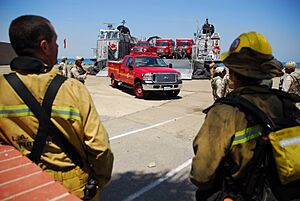Santa Catalina Island (California) facts for kids
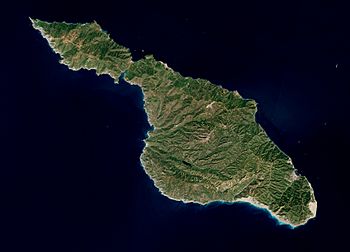
Santa Catalina Island satellite image
|
|
| Geography | |
|---|---|
| Location | Pacific Ocean |
| Coordinates | 33°23′N 118°25′W / 33.383°N 118.417°W |
| Archipelago | Channel Islands of California |
| Area | 74.98 sq mi (194.2 km2) |
| Highest elevation | 2,097 ft (639.2 m) |
| Highest point | Mount Orizaba |
| Administration | |
|
United States
|
|
| State | California |
| County | Los Angeles |
| Largest settlement | Avalon (pop. 3,460) |
| Demographics | |
| Population | 4,096 (2010) |
| Pop. density | 55 /sq mi (21.2 /km2) |
Santa Catalina Island (often called Catalina Island or just Catalina) is a rocky island off the coast of Southern California. It is part of the Channel Islands. The island is about 75 square miles (194 square kilometers) in size. It has hills, canyons, cliffs, and sandy beaches. The highest point is Mount Orizaba, which is 2,097 feet (639 meters) tall.
Catalina Island is about 29 miles (47 km) southwest of Long Beach, California. It is part of Los Angeles County. Most of the island is wild land, managed by the Catalina Island Conservancy.
Long ago, the island was home to the Tongva people. Later, it was claimed by Spain, then Mexico, and finally the United States. It became a popular tourist spot in the 1920s. Today, many people visit Catalina Island each year.
The main city on the island is Avalon, where most people live. Another small village is Two Harbors. You can reach the island by ferry from mainland California or by plane to the Catalina Airport.
Catalina Island has many different plants and animals. It has coastal scrub, chaparral, oak woodlands, and grasslands. Unique animals like the island fox live here. Visitors can enjoy hiking, biking, camping, and watching wildlife. The island has a mild, sunny climate, making it a great place to visit all year.
Contents
Island History: From Ancient Times to Today
People have lived on Catalina Island for a very long time, since about 7000 BC. The Tongva people lived here before Europeans arrived. They traveled between the island and the mainland for trade. The Tongva had villages all over the island. They were known for mining and trading soapstone, a soft rock found on the island. This rock was very popular along the California coast. The Tongva also saw the island as an important spiritual place.
The first European to visit the island was Juan Rodríguez Cabrillo in 1542. He claimed it for Spain and named it San Salvador. About 60 years later, in 1602, another Spanish explorer, Sebastián Vizcaíno, arrived. He renamed the island Santa Catalina, after Saint Catherine.
Sadly, diseases brought by the Spanish caused the native population to decline. By the 1830s, all native people were forced to leave the island.
In the late 1700s and early 1800s, Russian hunters came to Catalina Island. They hunted sea otters for their fur, which greatly reduced the otter population. The island was also a good spot for smugglers because it had many hidden coves.
In the 1850s, there was a small gold rush on Catalina Island. Miners came looking for gold, but they didn't find as much as in other parts of California.
Over the years, the island changed hands many times. It was owned by different people, including James Lick. By the late 1800s, only a few cattle herders lived there.
In 1887, George Shatto bought the island. He wanted to turn Avalon into a resort. He built the first hotel and pier. But he ran into financial trouble, and the island went back to the Lick family. Then, the Banning brothers bought the island in 1891. They continued Shatto's dream, building many tourist facilities.
In 1915, a big fire burned half of Avalon, including hotels and clubs. This, along with World War I, caused tourism to drop. The Banning brothers had to sell parts of the island.
In 1919, William Wrigley, Jr., who owned a chewing gum company, bought most of the island. He invested a lot of money to build new attractions, like the famous Catalina Casino, which opened in 1929. Wrigley also owned the Chicago Cubs baseball team, and they used Catalina Island for their spring training until 1951. After William Wrigley Jr. passed away in 1932, his son, Philip K. Wrigley, continued to improve the island.
During World War II, Catalina Island was closed to tourists. It was used by the military for training. After the war, tourism returned.
In 1975, Philip Wrigley gave most of the island (about 90%) to the Catalina Island Conservancy. This group helps protect the island's natural beauty and wildlife. The remaining parts of the island are still used for resorts and tourism.
In 2007 and 2011, wildfires burned parts of the island. Firefighters, including U.S. Marines, helped put them out, saving most buildings.
Island Geology and Climate
Catalina Island is one of the eight Channel Islands off Southern California. These islands are actually the tops of an ancient mountain range that is now mostly underwater.
The island is made of different kinds of rocks, including volcanic rocks and a special rock called "Catalina Schist." This schist is unique to the island and is one of its oldest rocks. Some beaches on the island even have shiny, silvery-grey sand because of the quartz in the rocks.
Catalina Island sits near where two large pieces of the Earth's crust, called tectonic plates, meet. This movement has shaped the island over millions of years, creating its steep cliffs, canyons, and hills. This also means Catalina Island was never directly connected to the mainland.
The island's geology is important for scientists who study how islands form and change. It also helps the Catalina Island Conservancy protect the island's natural features.
Island Climate and Weather
Santa Catalina Island has a warm, sunny climate with mild, wet winters and warm, dry summers. This type of weather is called a Mediterranean climate.
The average temperature in January is around 55°F (13°C), and in July, it's about 75°F (24°C). It rarely gets very hot or very cold. Sometimes, there is fog along the coast in summer, but it usually clears up by the afternoon.
The island gets about 13.7 inches (35 cm) of rain each year. Most of the rain falls in winter. Snow is very rare on the island.
El Niño's Impact on Catalina's Ocean Life
El Niño is a natural event where the Pacific Ocean waters get warmer than usual. Scientists have studied how El Niño affects the ocean around Catalina Island, especially the giant kelp forests.
Giant kelp is a very important plant in Catalina's underwater world. It provides food and shelter for many sea creatures.
- Positive Effects: Sometimes, El Niño can bring more nutrients to the ocean. This can help the kelp grow better in some areas.
- Negative Effects: However, the warmer water from El Niño can also harm kelp. Kelp needs cool, nutrient-rich water to thrive. When the water gets too warm, it can disrupt the normal flow of these nutrients, making it harder for kelp to grow.
Scientists continue to study these effects to understand how to protect Catalina's ocean ecosystems.
Island Wildlife: Plants and Animals
Since Catalina Island was never connected to the mainland, all its original plants and animals had to get there by chance. They might have floated across the ocean, been carried by the wind, or flown there. Over time, people also brought new plants and animals to the island.
Catalina is home to at least 50 endemic species. This means these plants and animals are found naturally only on Catalina Island and nowhere else in the world. They might have died out on the mainland but survived on the island where there were fewer dangers.
Island Flora: Unique Plants
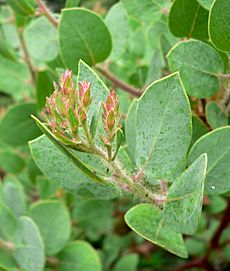
The most common native plant areas on Catalina Island are chaparral, coastal sage scrub, island oak-ironwood woodlands, and grasslands. These plant communities are very important for the island's many different species. They have adapted to the island's climate.
Catalina Island has about 400 types of native plants. Six of these are endemic, meaning they grow only on Catalina Island. Some examples include the Catalina manzanita, Catalina mahogany, and St. Catherine's lace.
The Wrigley Memorial & Botanical Gardens on the island is a great place to see and learn about these special plants. It helps show how important it is to protect the island's unique plant life.
Some plants have been brought to the island by people, like eucalyptus trees. These can sometimes grow too much and take over areas where native plants used to be. The Catalina Island Conservancy works hard to manage these introduced plants to protect the native ecosystem.
Island Fauna: Animals Big and Small
Catalina Island has five native land mammals:
- The island fox
- A type of California ground squirrel
- The Santa Catalina Island harvest mouse
- The Santa Catalina Island deer mouse
- The ornate shrew (though only one has ever been found)
The Catalina orangetip butterfly is a special insect found here. The Southern Pacific rattlesnake also lives on the island.
One of the most famous animals on Catalina is the bison herd. These American Plains Bison were brought to the island in the 1920s and 1930s for a movie. They became very popular with tourists. The herd grew quite large, but the Catalina Island Conservancy now manages their population to keep it healthy, usually around 150 bison.
Other animals that are not native but now live on the island include bullfrogs, wild cats, California mule deer, and rats. There are also about 12 Blackbuck (a type of antelope from India) living near the airport. Mule deer were brought in the 1920s and 30s, and their population is now much higher than on the mainland. In the past, there were also wild goats, pigs, and sheep, but these animals are no longer on the island.
Catalina Island is also a great place for birds. There are 37 types of birds that live on the island all the time. Many more marine birds and migrating birds visit. You can even watch live cameras of bald eagle nests on the island from February to July.
In the waters around the island, you can find many types of fish, like Garibaldi (bright orange fish), California sheephead, leopard sharks, and giant sea bass. Great white sharks are sometimes seen off the coast, usually near seal colonies. Common marine mammals include California sea lions and harbor seals.
Conservation Efforts
Most of Catalina Island is managed by the Catalina Island Conservancy. This group works to protect the island's natural and cultural heritage. They manage about 88% of the island's land, its shoreline, an airport, and over 200 miles of roads.

One of the Conservancy's main goals is to protect the island fox. This fox is an endangered species found only on Catalina. In 1999, a disease almost wiped out the fox population. But thanks to a successful program of breeding foxes in captivity, vaccinating them, and watching their numbers, the fox population has grown back. However, the foxes still face challenges like ear tumors and being hit by cars. The Conservancy has put up signs about the foxes and uses special trash cans to protect them from human garbage. They also ask dog owners to keep their pets on leashes to prevent diseases.
Another group, the Institute for Wildlife Studies, has helped bring bald eagles back to the island since the late 1970s. Bald eagles used to be common but disappeared due to pollution. Bringing them back also helps control the number of golden eagles, which can be a threat to the native island fox.
Managing Grazing and Fires
In the past, ranching on Catalina Island led to many sheep and cattle being brought here. These animals ate too much of the native plants, changing the island's plant life and harming the ecosystem. Conservationists realized this was a problem and started working to manage the grazing animals to protect the island's unique plants.
Fires are a natural part of California's climate. Historically, fires helped keep the ecosystem healthy. But in the 20th century, people tried to stop all fires to protect homes. This caused too much vegetation to build up, leading to a higher risk of very large, dangerous wildfires.
Today, fire management on Catalina Island tries to find a balance. They understand that fire can be good for the ecosystem. They use "controlled burns," where fires are intentionally set under safe conditions, to reduce extra plants and restore natural fire patterns. They also work to reduce fuel (dry plants) and teach people about fire safety. The goal is to protect both people and the island's natural environment.
Island Tourism: What to Do
Over a million people visit Catalina Island every year! Tourism brings a lot of money to the island.
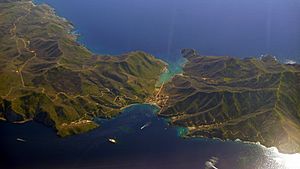
Avalon is the biggest town and offers many fun activities. You can take glass-bottom boat tours to see reefs and shipwrecks, or go scuba diving and snorkeling in the clear water. Lover's Cove and Descanso Beach are popular spots for diving. The Avalon Underwater Dive Park was the first non-profit underwater park in the United States. You might see bright orange Garibaldi fish and flying fish. Parasailing is also available. You can take jeep or bus tours into the island's wild interior, which is a protected area. The Love Catalina Island Tourism Authority helps visitors find information.
Two Harbors is a smaller village on the island's narrow middle section. It's a good starting point if you want to explore the western half of the island. You can get there by boat from San Pedro or by bus or boat from Avalon. While surfing isn't common, two beaches on the back side of Catalina, Shark Harbor and Ben Weston Beach, have good waves. There are also summer camps for kids and Boy Scouts on the island.
The Catalina Island Museum, now in its own building, is a great place to learn about the island's history. It has over 100,000 items, including Native American history, photos, and unique pottery and tiles made on the island long ago. The museum also has art exhibits and special events. From 1927 to 1937, pottery and tiles were made on the island by the Catalina Clay Products Company, and these items are now very popular with collectors.
Education on Catalina Island
Children in Avalon attend schools that are part of the Long Beach Unified School District. All grades, from kindergarten to high school, are on one campus in Avalon. The one-room schoolhouse in Two Harbors closed in 2014, so those students now travel to Avalon.
Thousands of students from the mainland visit the Catalina Island Marine Institute each year to learn about ocean science.
There is also a branch of the County of Los Angeles Public Library in downtown Avalon.
The USC Wrigley Institute for Environmental Studies has a research and teaching center called the USC Wrigley Marine Science Center. It's located near Two Harbors. This center has labs, dorms, a cafeteria, and a special chamber for divers. It's used by the University of Southern California for environmental studies. You can visit the institute on certain Saturdays.
Sports and Challenges
Catalina Island is the starting point for the Catalina Channel swim. This is a very challenging swim, part of the "Triple Crown of Open Water Swimming." In 1927, a 17-year-old swimmer named George Young was the first person to swim from Catalina Island to the mainland. The swim is about 20.1 miles (32.3 km) long. Since then, over 500 people have completed this amazing swim.
Island Infrastructure: Getting Around and Staying Connected
Transportation on Catalina Island
You can get to Catalina Island by passenger ferries from Long Beach, San Pedro, Dana Point, and Newport Beach. The ferry ride takes a little over an hour. Helicopter service is also available.
Many cruise ships also stop at Catalina Island. Passengers take smaller boats from the cruise ship to the shore.
The island has an airport called the Catalina Airport, also known as the Airport-in-the-Sky. It was built on a hilltop in 1941. In 2019, the Marines helped rebuild the runway. The airport is about 7 miles (11 km) northwest of Avalon.
Using regular cars on the island is very limited. There's a long waiting list (about 25 years!) to bring a private car. Most residents use golf carts or small cars. Tourists can rent golf carts or bicycles, or take a taxi. Only Avalon is fully open to the public without special permits. If you want to hike or bike in the wild parts of the island, you need to get a permit from the Catalina Island Conservancy.
Communication on Catalina Island
Because Catalina is an island, it has been a good place to try out new ways to communicate. In the past, gold miners used homing pigeons to send messages to the mainland much faster than regular mail. Pigeons were used until 1899!
In 1902, the first wireless telegraph station was built in Avalon. Then, in 1920, the world's first commercial wireless radio telephone system opened between San Pedro and Avalon. This was a big deal, but everyone could listen to the calls. So, in 1923, underwater cables were laid to make calls private. In 1946, Catalina also got the world's first commercial microwave telephone system.
Until 1978, Catalina Island was the last place in the US where telephone calls were still connected by human operators. Now, it uses modern phone systems.
Emergency Services and Utilities
The Los Angeles County Sheriff's Department has a station in Avalon to help keep the island safe.
Fire protection is provided by the Avalon Fire Department in the city and by the Los Angeles County Fire Department in other areas. There are two county fire stations on the island.
Paramedics and lifeguards are also part of the County Fire Department. The Catalina Island Medical Center in Avalon is the island's only hospital, open all the time.
For many years, the island got its water from a reservoir. Now, about 40% of Avalon's drinking water comes from a plant that removes salt from ocean water.
In the past, Avalon's old sewer pipes caused some ocean pollution. But the city invested money to fix the pipes, and now the water quality has greatly improved.
Notable People Connected to Catalina
- Spencer Davis, a musician.
- Author Zane Grey built a home in Avalon, which is now the Zane Grey Pueblo Hotel.
- Gregory Harrison, an actor, was born on Catalina Island.
- Marilyn Monroe lived in Avalon for several months in 1943 with her first husband.
|
See also
 In Spanish: Isla Santa Catalina (California) para niños
In Spanish: Isla Santa Catalina (California) para niños


